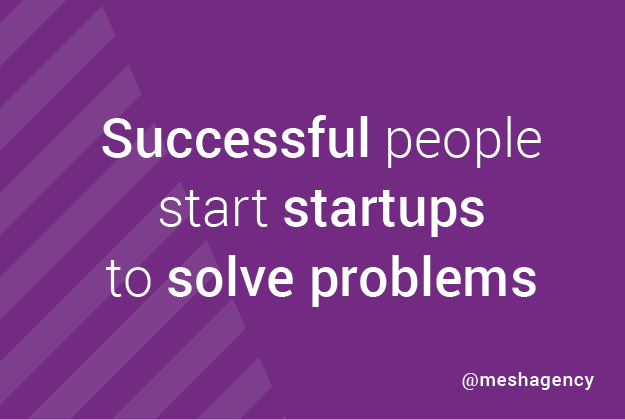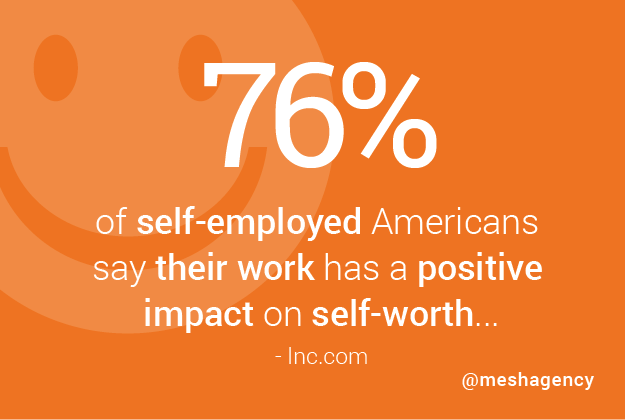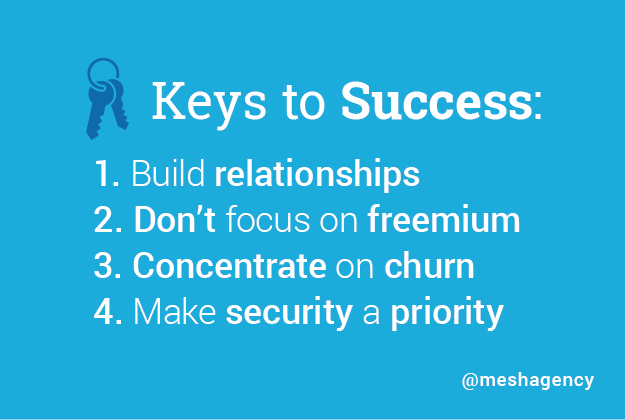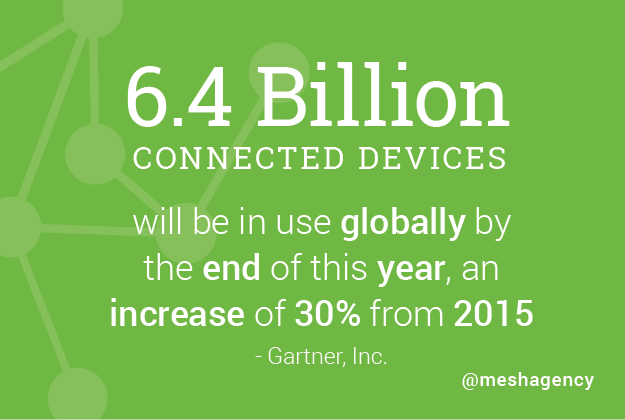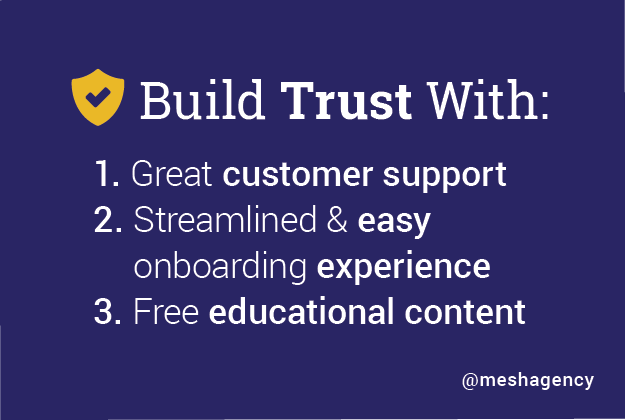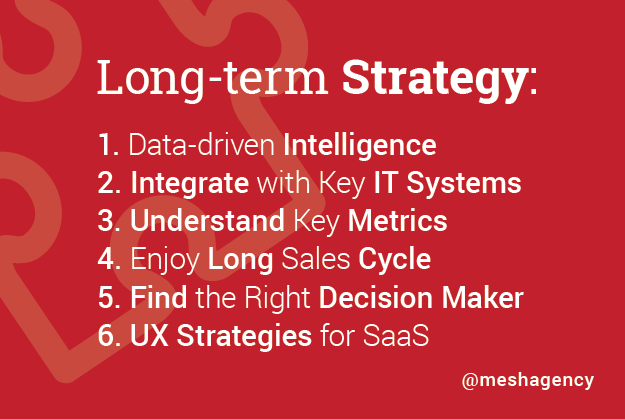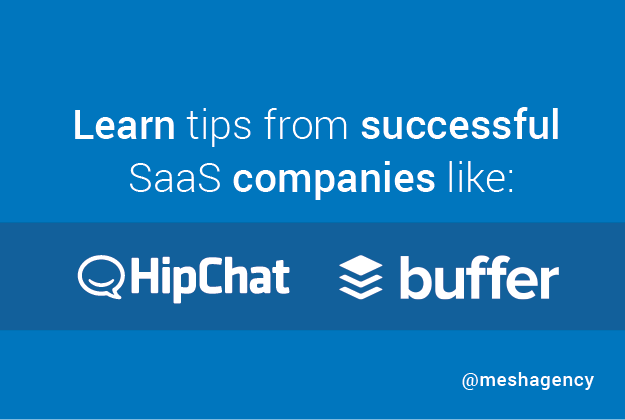It’s a whole wide world out there in digital marketing for Software-as-a-Service (SaaS) Startups. The abundance of data, technology and tools makes solutions that were unthinkable yesterday, today’s reality. But how do you get doctors who aren’t on social media to learn about your product (or even care)? How do you get quality control professionals across the globe to move from pen and paper to cloud and tablet? How do you get a fragmented c-suite audience to make the shift from disparate and costly office tools to a single, cloud-based solution?
Over the last few years our digital marketing agency has been thrilled to engage in various digital marketing engagements for SaaS cloud-based companies (90% of our business is international technology), and we’ve accumulated a bit of experience in the space.
Before I dig into the “how” and the “what,” let’s take a quick look at startups in 2016.
A Little Background: Why People Start Startups
There are a million good reasons to launch a startup, especially today when the climate for online innovation is both supportive and relatively inexpensive. In general, entrepreneurship in any form can be a distinguishing mark of leadership; paired with passion and creativity, such drive can often be a recipe for success. But what separates the winners from the losers? Why is it that some ideas become overnight successes and others, not so much?
According to Steve Tobak, the success of a venture has a lot less to do with the entrepreneur than you might think. While there are numerous good reasons to start your own business, Tobak says “that every single one of these reasons…is self-serving.” Your customers don’t care about your flexible schedule or tax deductions. Tobak goes on to say that there’s really only one good reason to start a business: “You’ve discovered a market need—a customer problem that begs to be solved.” If you’ve got the passion and dedication to get the job done, you, my friend, are on your way to the winner’s circle. In a nutshell, successful people start startups to solve problems.
A Supportive Environment for Startups
Like most people considering a startup, one of the greatest challenges you’ll face is finding the time to do it while balancing a full-time job. In fact, leaving the security of full-time employment is one of the hardest things you’ll have to do on your way to developing the next big thing. But fear not: there’s never been a better time in history to take the leap.
To help ease your worry, let’s take a look at the economy of startups. According to this report, Wells Fargo lent more than $22 billion to small businesses between 2014 and 2015. That number is expected to increase in 2016.
If you’re not interested in securing a small business loan, crowdfunding has become a very popular way to raise capital in a short period of time. Instead of repaying contributors with goods or services, new SEC rules allow small businesses to repay with equity on crowdfunding sites like Kickstarter and Indiegogo. The payoff for a good product or idea can be huge, so having a unique approach to your marketing is well worth the effort.
Finally, don’t discount angel investors or venture capitalists. According to this article, the proverbial funding bubble has yet to pop. VC funding is alive and well, and depending on your project you might be a good fit for one or two key investors. In today’s funding climate, it’s even possible to find investors “who are willing to take a long-term stake in the companies they fund, meaning those companies can stay independent and private indefinitely.” Evaluate your venture funding options sufficiently before you rule them out completely in 2016.
Aside from quitting your job and raising money, there are a few other important things to consider this year. For starters, let’s talk about your happiness. Did you know, for example, that “76 percent of self-employed Americans say their work has a positive impact on self-worth, compared with 67 percent of those with jobs,” reports Inc.com.
If you’ve ever wondered what owning your own business feels like, 2016 is the year to find out. Realizing your potential is a lot easier when you’re happy in your work—your customers will without a doubt feel the difference, too.
Keys to a Successful Cloud-based SaaS Startup
Aaron Orendorff breaks down the secrets to success in this article from Entrepreneur. First, you’ve got to establish relationships. Daniel Kushner says, “Neither your logo, blog or any press release is the face of your startup: you are.” Stand up for your beliefs, and surround yourself with likeminded thinkers.
Second, don’t rely on a business model where customers receive basic services free and then have to pay for premium services. Arie Sapanya says, “Freemuim is a stellar way to test your product, find out what your customers really want, and build your list but free users don’t pay the bills.” SaaS startups are eager to adopt freemium models to get the ball rolling. Learn to master the art of selling your product before you delve into a freemium only plan.
Third, focus on retention. SaaS companies, in particular, have a difficult time managing churn and developing a steady cash flow. Simon Grabowski says, “…successful SaaS products require a deeper understanding of client behavior and what they desire from the online experience.” A marketing team should manage client retention and acquisition separately.
Lastly, make security a priority. Web security has become a huge problem for online enterprises, and one that you should take most seriously if you want to minimize risk at the outset of your endeavors. Make the necessary investments to protect your software and your customers.
On Connected Consumers
Facebook CEO Mark Zuckerberg recently said that by 2030, he hopes to connect five billion of the world’s seven billion people. He said this during Facebook’s 12th anniversary celebration in February, when he explained that autonomous drones would provide basic free Internet in areas where Wi-Fi access was previously unviable. Imagine 3.5 billion more people on the Internet—it’s an incredible thought. More users mean more available data, and more data means more opportunities for SaaS startups.
The increasing complexity of network systems, connected devices, and streaming data has led to a “paradigm shift in how enterprises secure and manage information and systems,” says Stuart Bailey, from Tech Crunch. What good is all this data if we can’t make any sense of it?
In 2016, your job will become increasingly focused on using data to predict consumer behavior, and according to Bailey, much of this analysis should be focused on where the information comes from in real time. “For example, smart thermostats, water heaters and other ‘smart’ appliances can transmit back to manufacturers data about how homeowners use them. A car can send data about its operation, location and environment to its manufacturer, who can then push out software updates that enhance the user experience and the car’s performance, and even avoid problems before they occur.”
Data can make our lives easier and more convenient by providing companies with valuable insight about the way we live our daily lives. However, it’s a thin line to walk in 2016, as consumers become increasingly more aware of their personal data and online privacy. Still, as things become more connected, this line will fade further into the background. The Internet of Things (IoT), all things connected, presents both great opportunities for SaaS innovation and unique privacy issues for consumers.
In this article, Consumer Electronics Show (CES) summarizes the connected trends that emerged at this year’s exhibition. “While much of the requisite technology exists—there are sensors, actuators, communication protocols, application platforms, user hubs, and interfaces for almost everything—there is as yet no interoperability or interconnected ecosystem among all these interfaces. Most important, there is as yet no clear commercial value proposition for consumers or an effective response to their security concerns.”
IoT Services
We are approaching the precipice of the IoT without so much as a whisper as to how or who will effectively manage all the data and the communications among these various devices.
In 2015, global traffic grew 74 percent and the fourth generation (4G) network overtook 3G for the first time, reports Cisco. What’s more, Cisco predicts that by 2020, more than three-fifths of all connected devices will be “smart” devices, 66 percent of which will be able to connect to an IPv6 mobile network. In other words, if you think there’s a lot of data streaming now, you haven’t seen anything yet.
And it’s not just smartphones, either. Garnter, Inc. reports that 6.4 billion connected devices will be in use globally by the end of this year, an increase of 30 percent from 2015. The IoT is estimated to support total service spending of $235 billion this year, where services are currently the most popular professional category.
“IoT services are the real driver of value in IoT, and increasing attention is being focused on new services by end-user organizations and vendors,” said Gartner analyst Jim Tully.
Customer Support and Relations
Once you’ve decided to build a startup, and you’ve considered the keys to success outlined above, it’s time to create your SaaS strategy, and decide how your service is going to fit in with connected consumers.
According to Kissmetrics, building a successful strategy often doesn’t involve selling anything at all. Instead, you will be better served by helping customers best achieve their goals.
An easy way to build trust with consumers, while also helping them achieve their goals, is to provide great customer support. Kissmetrics suggests that you do this by offering a detailed FAQ page, as well as reliable phone support for customers.
Next, be sure your onboarding experience is streamlined and easy to follow. After someone signs up for your service, the buck doesn’t just stop. Your goal shouldn’t be to sell the software; it should be to help your customer thrive using the software.
Offer free content that focuses on education. According to Kissmetics, “Ongoing training is a huge value for users. MailChimp, an email marketing provider, has a large number of free eBooks available to all users…MailChimp knows that making their users smarter and more successful is good for the bottom line.”
Consider expanding your educational content into other areas like a blog, web video, podcast or other shareable media that make learning accessible and fun.
Digital Marketing for SaaS
Once you’ve established these necessary elements, it’s time to consider your long-term SaaS strategy, which should focus on digital marketing. According to Business2Community, “…ignoring marketing as part of your growth strategy is a deadly mistake, especially if you’re a B2B company and can’t solely rely on public buzz to acquire customers. SaaS companies need marketing.”
SaaS marketing is particularly important because most SaaS startups are more concerned with the product than they are with public perception. However, that’s a fading theory, and one that shouldn’t stop you from utilizing some of these helpful SaaS digital marketing tactics:
1. Data-driven Marketing Intelligence
This tactic is one you likely predicted—it aligns with consumer and technology trends, and assumes the IoT is as robust as many have estimated it will be in the coming years.
Data-driven intelligence involves taking the statistical data we collect from our customers, and using it to build better products and services to help those same customers.
According to Tech Trends, “While companies have been experimenting with personalization to one degree or another for years, today, the abundance of data and sensors can provide a much more complete picture from which companies can personalize their products and services at scale.”
Personalizing a SaaS experience through data-driven intelligence is a top priority among 81 percent of executives, according to this study. “To truly become a leader in the Internet of Me space, businesses will have to figure out how the customer experience they ‘own’ relates to other experiences in the customer’s life or how they can help to deliver the outcomes that a customer is trying to achieve.”
2. Integrate With Key IT Systems
Most industries have begun to modernize their online systems, functionally expanding or substituting traditional office applications with cloud-based software-as-a-service.
According to this forecast analysis, noted by Channelnomics, “The SaaS-fueled modernization and digital-transformation trends mean that worldwide spending on enterprise application software is now expected to grow 7.5 percent this year to just shy of $150 billion…”
In this recent study, Gartner found that 45 percent of IT decision-makers believe modernization with cloud-based SaaS was a top priority this year. By the year 2020, Gartner estimates that more than 75 percent of organizations will be using big data to “…improve business decision-making as they shift focus from measurement to analysis, forecasting and optimization.”
If you’re a SaaS startup, organizations are looking for you. Depending on the size and scope of their modernization needs, they might choose to partner with a lightweight SaaS startup.
“The leap to SaaS CRM does not have to be tricky or complicated,” explains George Lawton. “It all depends on the goals of the organization. If the main objective is a quick fix to get the sales department excited and better organized, many of these benefits can be achieved with a simple installation using mashups to integrate into ERP on the fly.”
3. Understand Key Marketing Metrics
According to this expounded report by David Skok, there are three variables that make SaaS unique in the marketplace: 1) Acquiring the customer; 2) Retaining the customer; and 3) Monetizing the customer.
Skok says, “Traditional business metrics totally fail to capture the key factors that drive SaaS performance. In the SaaS world, there are a few key variables that make a big difference to future results.” In the SaaS world, this is an artful dance calculated using unit economics, or equations that help predict things like cash flow, profitability, the lifetime value of a typical customer, and cost per install.
Skok explains, “SaaS is usually a ‘winner-takes-all’ game, and it is therefore important to grab market share as fast as possible to make sure you are the winner in your space.”
In order to grab your slice of the pie, it’s important to understand key metrics—things like revenue churn vs. customer churn—and use your analysis to drive the decision-making process as you move forward.
4. Enjoy the Long-term SaaS Customer Lifecycle
Software-as-a-service doesn’t seem like it has much of a marketing and sales cycle. In fact, the very nature of software often translates into purchases that take a few days, maybe only a few hours—quite the opposite of traditional B2B sales cycles! However, SaaS has the unique advantage of creating a customer lifecycle, which outlasts the original purchase, if the service is good.
According to Gartner, 20 percent of your current customer base will provide 80 percent of future revenue. Customer retention is your bread and butter. Lincoln Murphy notes, “When creating your SaaS marketing plan, you must understand that your business model of choice is a fully integrated architecture where all aspects of the business — product, support, revenue model and marketing — are tightly coupled.” This aligns with what we talked about at the beginning of this article; the goal is to help your customers succeed rather than focus on selling a product. By providing a great service to your clients, you will enjoy a longer lifecycle from them.
5. Find the Right Decision-Maker
There’s nothing wrong with cold-emailing potential clients to notify them about your new SaaS startup and offerings, but it’s a good idea to know who those people are before you go blowing up anyone’s personal inboxes.
For example, if you’re writing an email to the person who would be using the tool (like the director of marketing), your email might sound a little different than if it were addressed to the person who would have to sign off on paying for it (like an executive, or founder.)
In addition to personalization, Kissmetrics also recommends that your correspondence have something of value to say, be thoughtful and well written, allow readers to unsubscribe easily, and not badger potential clients. Check out some more key email marketing tips.
6. UX Strategies for SaaS
Lastly, and in alignment with the goal of creating a positive customer experience, your SaaS user experience should be touching on notes that align with popular user trends.
For starters, if you can create a mobile responsive version of your product, that’s a huge plus. According to Alix Edquist, “If a website doesn’t scale to mobile, tablet, mini-tablet, mini-mini-mini…and the list goes on, it reads as an insult.”
Develop dynamic features that make sense for a mobile user. “Features like push notifications, instant reminders, offline functionality, queuing, GPS tracking, automatic updates and the list goes on, provide a level of interaction and intuitiveness that make apps a dynamic right-hand buddy,” says Edquist.
And if it makes sense for your software, consider wearable devices and how those might improve your ability to achieve the end user’s goals.
Getting Started with Digital Marketing for Your SaaS Startup
They say imitation in the highest form of flattery. Learning a few tips from successful SaaS companies can be enlightening. In fact, many of the decisions that worked for them could very well work for you and your startup.
Take a look at what HipChat did when it realized it didn’t have money to kick off the first round of advertising. Co-founder and CEO Pete Curley asked the CBS sales rep to notify him if there were ever any empty billboards, typically a result of someone backing out of a contract at the last minute. Sure enough, he was able to save thousands on his startup marketing costs, and the SaaS company grew 300 percent in online searches after pairing the new brand name with a timely Internet character called Y-U-No guy from Rage Comics.
Buffer is another SaaS breaking free from the mold. In the beginning, Buffer SaaS marketing blogged about topics related to social media, which makes sense (it’s scheduling software for social media), but to no avail. So, the company switched things up, and started blogging about topics that interested people who already had a large social media following—it was now engaging the influencers. Buffer increased social media shares by 25 percent just by changing the angle of the marketing and message.
The point is, there have been plenty of successful SaaS companies that all started from where you’re sitting right now. If you’ve been toying with the idea of entrepreneurship for a while, this year might be the best time for you to get started.
If you’re interested in learning more about what it takes to successfully start digital marketing for your SaaS solution or app, check out our 24 best practices for marketing your app, and contact us today.


